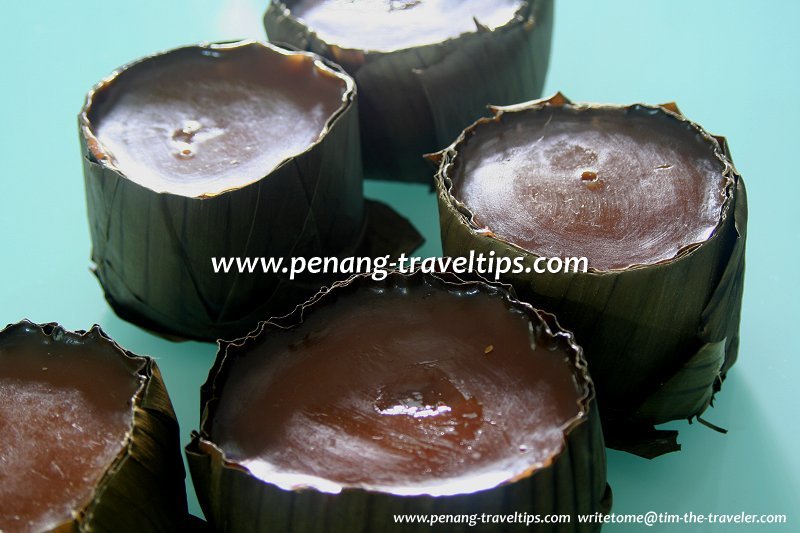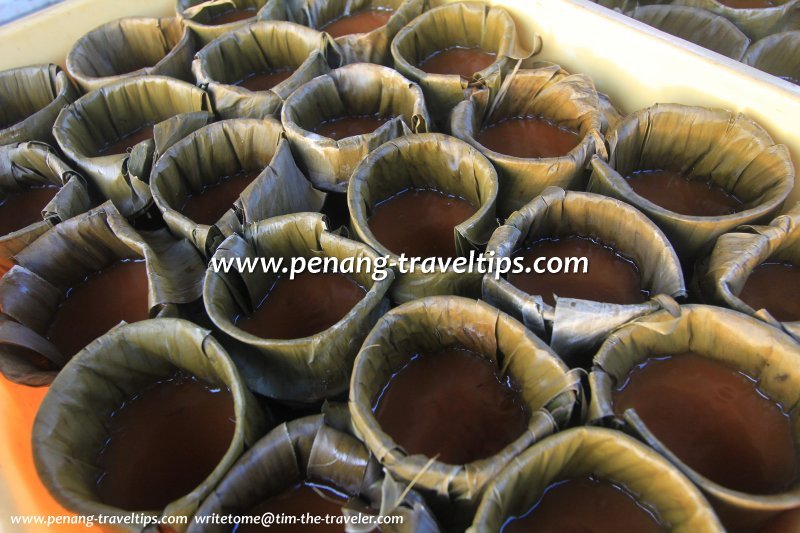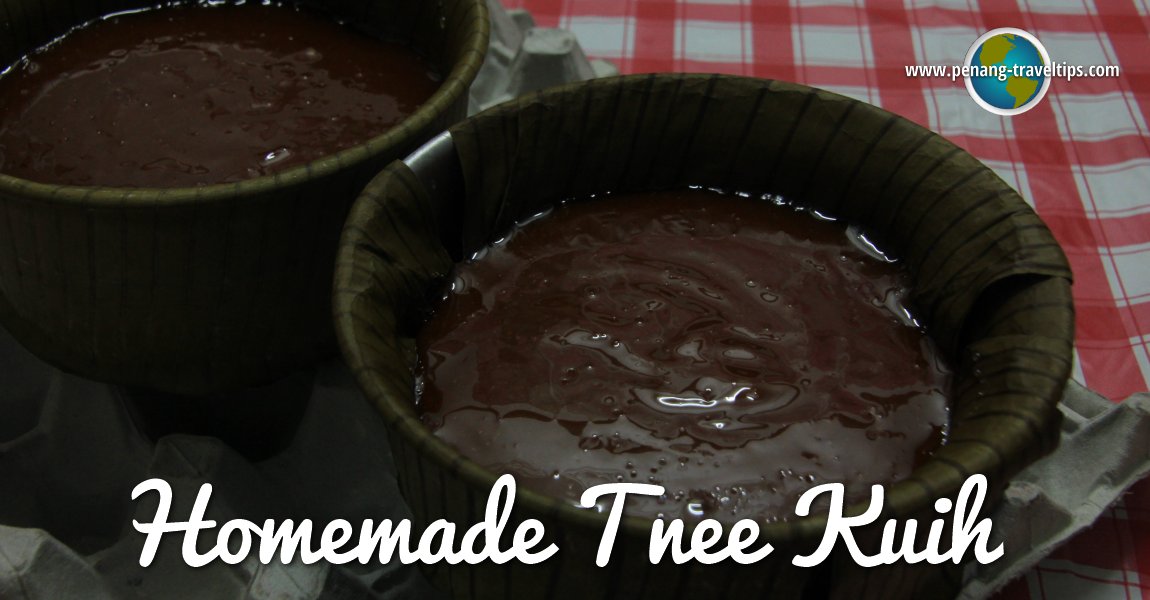 Tnee Koay (29 November 2008)
Tnee Koay (29 November 2008)
Tnee Koay (Alternative spelling, Tnee Kuih; Traditional/Simplified Chinese, Mandarin: 年糕; Cantonese Jyutping: Nin4 Gou1; Penang Hokkien: Tnee3 Kuih4, 甜粿) is a sticky rice cake that is popular during Chinese New Year. The name tnee koay is Hokkien and translated literally, means "sweet cake". It is known in Mandarin as nian gao, a name to mean "year cake", or "new year cake". The term nian gao refers to different types of cakes. The Shanghai nian gao is very different in appearance from the Guangdong variety, for example. The one similarity among them is that they are all made from glutinous rice.
The tnee koay that is known in Penang (and Malaysia, for that matter) has been given a local spin. Made with sugar, glutinous rice and water, the mixture is steamed until the sugar caramelize. The batter is then poured into moulds made from banana leaf - the basket-like appearance of these banana-leaf moulds give the tnee koay its Malay name, kuih bakul. It is very common nowadays to find store-bought tnee koay in plastic moulds.
When freshly made, tnee koay is very soft. Freshly made tnee koay is very sticky. Slicing it from the mould, tnee koay will stick on anything that comes into contact with it, on your knife, to your fingers, to your teeth. This very nature of tnee koay makes it the ideal offering to the Kitchen God (see below).
After being left to air for a few days, tnee koay slowly hardens. Then it is easier to slice. The hardened tnee koay can be deep fried to make a delicious snack. A slice of tnee koay is usually sandwiched with yam or sweet potato, and then deepfried in batter. The batter becomes crispy while the tnee koay softens to almost melting. It takes great when eaten hot from the wok.
Our homemade Tnee Kuih
My wife often makes Tnee Kuih especially in the run up to Chinese New Year. Even though we are Christians, and therefore there's no kitchen god in our kitchen, we make it to enjoy the delicacy during the festive season.Our 2017 Homemade Tnee Kuih
Details Tnee Koay on sale at the Jelutong Market in Penang (16 February 2013)
Tnee Koay on sale at the Jelutong Market in Penang (16 February 2013)
Tnee Koay and the Kitchen God
As mentioned earlier, tnee koay is the ideal offering to the Chinese Kitchen God. The Kitchen God, known as Chau Koon in Hokkien and Zao Jun or Zao Shen in pin yin. The name Zao Jun means "stove master" while Zao Shen means "stove spirit". The Taoists make an offering to the Kitchen God as a send-off for the god which is embarking on his annual journey to heaven, to report to the supreme deity of the Taoist pantheon, the Jade Emperor, of the activities in the household over the past year.The offering is made on the eve of the 24th day of the 12th lunar month among the Chinese of southern China, from whom the Chinese in Penang were descended, while the Chinese in northern China make the offering on the eve of the 23th. The Jade Emperor either blesses or punishes the household based on the Kitchen God's report. The tnee koay is therefore offered to "sweeten the pot", so to speak, ensuring that the Kitchen God provides a flattering report - and if he has nothing good to say about the family, then hopefully the sticky confection will keep his lips sealed.
 Modern tnee koay (16 February 2013)
Modern tnee koay (16 February 2013)
The worship of the Kitchen God does back to the 2nd century BC. According to Chinese mythology, the Kitchen God used to be a mortal man named Zhang Dan. He was married to a virtuous woman, but many years thereafter fell in love for a younger woman. The heavens punished him by making him blind. Thereafter his young lover deserted him, and he wandered aimlessly thorough the country as a beggar, until eventually he arrived at the doorstep of his wife's house, begging for alms. His wife recognized him, brought him in, and even prepared a fabulous meal for him.
Overwhelmed by the kindness shown to him, Zhang Dan wept, and through his tears, his vision was restored. When he saw that it was his wife who had prepared for him the fabulous meal, he threw himself into the kitchen fire in remorse. His wife tried to save him but in vain. From then onwards, Zhang Dan is believed to be the spirit that inhabits the stove.
 Tnee Kuih (9 January 2016)
Tnee Kuih (9 January 2016)
List of Penang Nyonya Kuih
[an error occurred while processing this directive]
Copyright © 2003-2025 Timothy Tye. All Rights Reserved.

 Go Back
Go Back